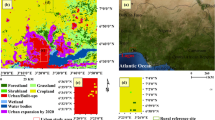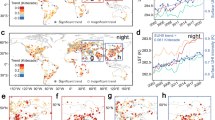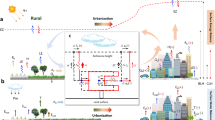Abstract
China has warmed rapidly over the past half century1 and has experienced widespread concomitant impacts on water availability, agriculture and ecosystems2. Although urban areas occupy less than 1% of China’s land mass, the majority of China’s observing stations are situated in proximity to urban areas, and thus some of the recorded warming is undoubtedly the consequence of rapid urban development, particularly since the late 1970s3,4,5. Here, we quantify the separate contributions of urbanization and other external forcings to the observed warming. We estimate that China’s temperature increased by 1.44 °C (90% confidence interval 1.22–1.66 °C) over the period 1961–2013 and that urban warming influences account for about a third of this observed warming, 0.49 °C (0.12–0.86 °C). Anthropogenic and natural external forcings combined explain most of the rest of the observed warming, contributing 0.93 °C (0.61–1.24 °C). This is close to the warming of 1.09 °C (0.86–1.31 °C) observed in global mean land temperatures over the period 1951–2010, which, in contrast to China’s recorded temperature change, is only weakly affected by urban warming influences6. Clearly the effects of urbanization have considerably exacerbated the warming experienced by the large majority of the Chinese population in comparison with the warming that they would have experienced as a result of external forcing alone.
This is a preview of subscription content, access via your institution
Access options
Subscribe to this journal
Receive 12 print issues and online access
$209.00 per year
only $17.42 per issue
Buy this article
- Purchase on Springer Link
- Instant access to full article PDF
Prices may be subject to local taxes which are calculated during checkout




Similar content being viewed by others
References
Committee of Chinese National Assessment Report on Climate Change Third China’s National Assessment Report on Climate Change (in Chinese) (China Science Press, 2016).
Qin, D. H., Ding, Y. J. & Mu, M. (eds) Climate and Environment Changes in China (Synthesis Report) 87(in Chinese) (China Meteorological Press, 2012).
United Nations Development Program China Human Development Report 2013. Sustainable and Liveable Cities: Toward Ecological Urbanisation 103 (China Translation and Publishing Corporation, 2013).
Jones, P. D., Lister, D. H. & Li, Q. Urbanization effects in large-scale temperature records, with an emphasis on China. J. Geophys. Res. 113, D16122 (2008).
Ren, G. et al. An integrated procedure to determine reference station network for evaluating and adjusting urbanization bias in surface air temperature data. J. Appl. Meteorol. Climatol. 54, 1248–1266 (2015).
Hartmann, D. L. et al. in IPCC Climate Change 2013: The Physical Science Basis (eds Stocker, T. F. et al.) 187–194 (Cambridge Univ. Press, 2013).
Sun, Y. et al. Rapid increase in the risk of extreme summer heat in Eastern China. Nature Clim. Change 4, 1082–1085 (2014).
Ding, Y. H. et al. National assessment report on climate change (I): climate change in China and its future trend. Adv. Clim. Change Res. 2, 3–8 (2006).
Zhang, X., Zwiers, F. W. & Stott, P. A. Multimodel multisignal climate change detection at regional scale. J. Clim. 19, 4294–4307 (2006).
Wen, H. Q., Zhang, X., Xu, Y. & Wang, B. Detecting human influence on extreme temperatures in China. Geophys. Res. Lett. 40, 1171–1176 (2013).
Xu, Y., Gao, X. J., Shi, Y. & Zhou, B. T. Detection and attribution analysis of annual mean temperature change in China. Clim. Res. 63, 61–71 (2015).
Zhao, P. et al. Trend of surface air temperature in eastern China and associated large-scale climate variability over the last 100 years. J. Clim. 27, 4693–4703 (2014).
Ren, G. Y., Zhou, Y. Q. & Chu, Z. Urbanization effect on observed surface air temperature trend in North China. J. Clim. 21, 1333–1348 (2008).
Ren, G. Y. & Zhou, Y. Q. Urbanization effects on trends of extreme temperature indices of national stations over mainland China, 1961–2008. J. Clim. 27, 2340–2360 (2014).
Yang, X., Hou, Y. & Chen, B. Observed surface warming induced by urbanization in east China. J. Geophys. Res. 116, D14113 (2011).
Zhang, A. Y. et al. Urbanization effect on surface air temperature trends over China. Acta Meteorol. Sin. 68, 957–966 (2010).
Wang, F., Ge, Q., Wang, S., Li, Q. & Jones, P. D. A new estimation of urbanization’s contribution to the warming trend in China. J. Clim. 28, 8923–8938 (2015).
Zhang, L., Ren, G. & Ren, Y. Identification of urban heat island (UHI) effect in a single extreme high temperature event. Clim. Environ. Res. 20, 167–176 (2015).
Hegerl, G. C. et al. Multi-fingerprint detection and attribution of greenhouse-gas and aerosol-forced climate change. Clim. Dynam. 13, 613–634 (1997).
Allen, M. R. & Stott, P. A. Estimating signal amplitudes in optimal fingerprinting. Part I: Theory. Clim. Dynam. 21, 477–491 (2003).
Ribes, A., Planton, S. & Terry, L. Application of regularised optimal fingerprinting to attribution. Part I: method, properties and idealised analysis. Clim. Dynam. 41, 2817–2836 (2013).
Xu, W. H. et al. Homogenization of Chinese daily surface air temperatures and analysis of trends in the extreme temperature indices. J. Geophys. Res. 118, 9708–9720 (2013).
Tan, M. et al. Urban population densities and their policy implications in China. Habitat Int. 32, 471–484 (2008).
Jones, P. D. & Lister, D. H. The urban heat island in Central London and urban-related warming trends in Central London since 1900. Weather 64, 323–327 (2009).
Wang, F. & Ge, Q. S. Estimation of urbanization bias in observed surface temperature change in China from 1980 to 2009 using satellite land-use data. Chin. Sci. Bull. 57, 1708–1715 (2012).
Hegerl, G. C. et al. in Meeting Report of the Intergovernmental Panel on Climate Change Expert Meeting on Detection and Attribution of Anthropogenic Climate Change (eds Stocker, T. F. et al.) 1–8 (IPCC Working Group I Technical Support Unit, University of Bern, 2010).
Taylor, K. E., Stouffer, R. J. & Meehl, G. A. An overview of CMIP5 and the experiment design. Bull. Am. Meteorol. Soc. 93, 485–498 (2012).
Fyfe, J. C., Gillett, N. P. & Zwiers, F. W. Overestimated global warming over the past 20 years. Nature Clim. Change 3, 767–769 (2013).
Bindoff, N. L. et al. in IPCC Climate Change 2013: The Physical Science Basis (eds Stocker, T. F. et al.) 867–931 (Cambridge Univ. Press, 2013).
Jones, G. S., Stott, P. A. & Christidis, N. Attribution of observed historical near surface temperature variations to anthropogenic and natural causes using CMIP5 simulations. J. Geophys. Res. 118, 4001–4024 (2013).
Santer, B. et al. Volcanic contribution to decadal changes in tropospheric temperature. Nature Geosci. 7, 185–189 (2014).
Revi, A. et al. in IPCC Climate Change 2014: Impacts, Adaptation, and Vulnerability (eds Field, C. B. et al.) 535–612 (Cambridge Univ. Press, 2014).
World Urbanization Prospects: The 2014 Revision, Highlights (ST/ESA/SER.A/352) 32 (United Nations, Department of Economic and Social Affairs, Population Division, 2014).
Acknowledgements
We thank G. Flato, A. Cannon and K. Anderson for their comments. Y.S., T.H. and G.R. are supported by China funding agencies through multiple grants: 2012CB955900, GYHY201406020, 2012CB417205, GYHY201206012. We acknowledge the Program for Climate Model Diagnosis and Intercomparison and the World Climate Research Programme’s Working Group on Coupled Modelling for their roles in making the WCRP CMIP multi-model data sets available.
Author information
Authors and Affiliations
Contributions
X.Z., Y.S. and F.W.Z. designed the analysis. Y.S., X.Z. and T.H. conducted the analysis. Y.S., X.Z. and F.W.Z. wrote the paper. G.R. identified the rural stations for the estimation of the urbanization effect in temperature and helped in the analysis and the interpretation of the urbanization effect.
Corresponding author
Ethics declarations
Competing interests
The authors declare no competing financial interests.
Supplementary information
Supplementary Information
Supplementary Information (PDF 1455 kb)
Rights and permissions
About this article
Cite this article
Sun, Y., Zhang, X., Ren, G. et al. Contribution of urbanization to warming in China. Nature Clim Change 6, 706–709 (2016). https://doi.org/10.1038/nclimate2956
Received:
Accepted:
Published:
Issue Date:
DOI: https://doi.org/10.1038/nclimate2956
This article is cited by
-
Effects of landscape pattern on land surface temperature in Nanchang, China
Scientific Reports (2024)
-
Direct and indirect impacts of land use/cover change on urban heat environment: a 15-year panel data study across 365 Chinese cities during summer daytime and nighttime
Landscape Ecology (2024)
-
Global 30 meters spatiotemporal 3D urban expansion dataset from 1990 to 2010
Scientific Data (2023)
-
Future extreme high-temperature risk in the Beijing-Tianjin-Hebei urban agglomeration of China based on a regional climate model coupled with urban parameterization scheme
Theoretical and Applied Climatology (2023)
-
Unprecedented Hot Extremes Observed in City Clusters in China during Summer 2022
Journal of Meteorological Research (2023)



